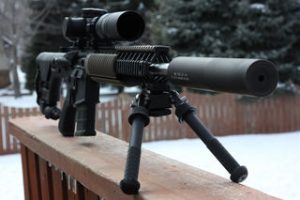 As the nation reels from Monday’s horrific mass shooting in Las Vegas, politicians on the left are calling for new regulations on firearms. In our modern society, it’s the standard response that after every major mass shooting, Democrats make the case for passing more stringent laws about what types of firearms are available and who can own them. And people who support gun owners’ rights often make the argument that guns don’t kill people; people kill people. But what does the evidence say?
As the nation reels from Monday’s horrific mass shooting in Las Vegas, politicians on the left are calling for new regulations on firearms. In our modern society, it’s the standard response that after every major mass shooting, Democrats make the case for passing more stringent laws about what types of firearms are available and who can own them. And people who support gun owners’ rights often make the argument that guns don’t kill people; people kill people. But what does the evidence say?
First, let’s take a look at the big picture: More than 30,000 people die each year because of gun violence, and another 78,000 are injured. These rates are substantially higher than those of almost every other nation in the world and are at least seven times higher than those in other developed nations including Australia, Canada, France, Germany, India, Italy, Japan, South Korea, Spain, Sweden and United Kingdom.
Two large analyses provide insights on evidence-based methods for reducing gun violence. The first was published last year by a group of public health researchers in the journal Epidemiological Reviews. They analyzed 130 studies from 10 countries that explored the connections between firearm regulations and gun violence.
The analysis uses data from a wide variety of firearms regulations including laws about sales and ownership, storage regulations, laws targeting specific types firearms and ammunition and punishments for gun offenders.
The authors conclude that specific laws combining different types of firearm regulations is the best way to reduce deaths from gun violence. They also found that some specific regulations – such as background checks – are the most effective.
In 2013, the American Psychological Association took a slight different approach to analyzing the best ways to reduce the gun violence. Their evidence-based report was written by a panel of ten experts from disciplines ranging from pediatric medicine to criminal justice, who reviewed the body of evidence on gun violence, including homicide, suicide and mass shootings. It takes a closer look at the motivations that drive people to commit acts of gun violence.
The main message from the American Psychological Association is that there are complex reasons that people resort to gun violence, which differ for every situation. “For this reason, there is no single profile that can reliably predict who will use a gun in a violent act,” the authors write.
But there are some data that can help predict those individuals most likely to commit acts of violence with firearms, and how to prevent them.
- The most consistent and powerful predictor that someone will resort to gun violence is a history of violent behavior.
- Other than previous violence, gun violence is related to a combination of individual, family, school, peer, community, and social risk factors that interact over time during childhood and adolescence.
- Prevention programs that focus on can reduce the likelihood that firearms will be introduced into conflicts. One successful program is called Behavioral Threat Assessment. It relies on a team of people spread throughout an organization – such as a university or workplace – who work to identify suspicious, disruptive or unusual behaviors, and then report this to law enforcement officers. Research finds this method is one of the most effective ways to prevent potential acts of gun violence in public spaces.
- Males commit most gun violence. Psychologists need to develop programs that change male gender expectations of toughness, and violence. There are currently youth programs to help develop new social norms around what it means to be masculine. Additional studies are needed to assess whether these program help reduce the risk of violence among participants.
- Most people suffering from a mental illness are not dangerous. For the few who become violent as a result of a mental health problem, medical treatment helps to prevent violence. Because most people with mental illnesses in the United States don’t receive adequate services, it is difficult to identify people who may be a potential threat.
- Violence prevention programs need to span the life course. For example, early childhood programs can help parents raise emotionally healthy children, while programs for criminal offenders can help identify those likely to commit violent acts in the future.
- Policies that prevent high-risk groups from obtaining guns — including domestic violence offenders, people convicted of violent misdemeanor crimes, and people with mental illness and a history of violence — have been shown to reduce violence.
- The evidence shows that public health campaigns on safe gun storage can help reduce accidental gun deaths and prevent violent individuals from having access to guns.
The take-home message: There is evidence of viable ways to reduce gun violence in the United States, but there is not one magic solution. We need a variety of solutions that address social norms, child development, mental illness and policies that regulate the access to guns.



Speak Your Mind